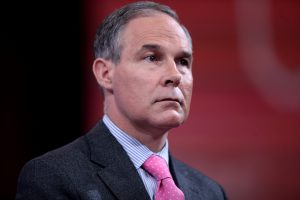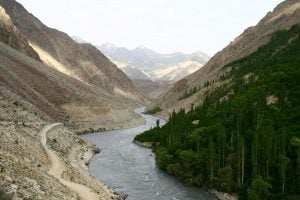Back in 2011, I testified in front of a subcommittee of the House Energy and Commerce Committee on Chinese environmental regulation. Surprisingly, the actual subject of the hearing was a proposed bill (i.e. law) on US energy policy that had nothing to do with China at all. So why were we discussing Chinese regulation?
The Republican committee members that called the hearing essentially had two arguments: first, that China didn’t regulate the environment and this put the US at a competitive disadvantage, and second, that US air and water were already clean so the country no longer needed the infrastructure of environmental protection.
The argument that environmental protection is somehow inimical to economic growth will be familiar to many readers. It’s also wrong. These representatives were rehashing this old argument even though fifty years of environmental protection in the US has shown the opposite: states that rigorously pursue environmental protection, such as California and those in the northeast, actually grow faster.
A diminished EPA
Despite the historic success of US environmental regulation, we now run the risk of losing substantial ground.
The new Environmental Protection Agency (EPA) administrator Scott Pruitt is most famous for filing 14 lawsuits against the EPA as Oklahoma attorney general. While fighting the EPA and arguing for states rights, Pruitt actually closed down the environmental enforcement division of his own office.
Oklahoma faces real environmental challenges, and moreover, demonstrates that new and unpredictable environmental problems arise as technologies change. In the last few years, Oklahoma has become as earthquake prone as California, despite not previously being associated with earthquakes. While these are blamed in the public mind on the controversial drilling technique called fracking, more accurately they are connected to wastewater disposal wells used by the oil and gas industry for most types of drilling, not just fracking. Indeed the state has begun to regulate and even close some of these wells. But while the state’s governor has expressed considerable alarm, Pruitt showed only the mildest concern about this situation in an exchange with Senator Bernie Sanders at his confirmation hearing.
Pruitt was not involved in trying to protect his state from these new threats. Instead, he challenged the EPA in virtually every facet of its work. His 14 lawsuits against the EPA included seven challenging the regulation of traditional air pollutants, six regarding climate change regulation, and one against the clean water rule. All 14 took up concerns of the state’s energy sector. Moreover, Pruitt even sued the EPA’s rules on ozone pollution, when both of his state’s two largest cities rank among the 25 worst cities in the nation for ozone pollution.
Much of the public discussion regarding Pruitt as EPA administrator has focused on climate change, given both his aggressive lawsuits against President Obama’s Clean Power Plan, the general opposition of Republican politicians to climate action, and the appointment of well-known climate denier Myron Ebell to head Trump’s energy and environment transition team. The concerns are warranted. In his exchange with Senator Sanders at his confirmation hearing, Pruitt would only say that CO2 “impacts” the climate, not that it is the main cause of climate change. The main issue will not be out-and-out denial of climate change as favoured by Ebell, but an intensely legalistic approach that attempts to tie the EPA’s hands. Pruitt has argued, for example, that the Clean Air Act does not allow the government to provide cap and trade options for power plants needing to reduce climate gases. His alternative plan maintains that the only possible remedy for coal-fired power plants is plant-specific efficiency improvements. This approach would hardly yield the needed reductions.
It is unlikely that we will see much progress on climate change during the Trump administration. Indeed, progress was imperilled before Trump came into office from court challenges, especially to the Clean Power Plan. But public attention on climate change is high, and it seems likely the US will maintain at least some presence in international agreements. Trump’s new Secretary of State Rex Tillerson, with no history of support for climate action, has nevertheless said that he wants to ensure the US has “a seat at the table,” which is generally interpreted as mild support for engagement in the international process.
At the same time, forces well outside of federal policy, including the growth of natural gas and renewable energy production, the continued decline of the coal industry, and shifts in demand, have US greenhouse gas emissions to a 25 year low, down 12% from their 2007 peak. These trends are likely to continue. Thus, while we cannot be certain, it is quite possible that we will see inaction as these larger economic forces continue to drive a lower carbon footprint for the US. Will it be fast enough? Not to avert catastrophic climate change, but it seems unlikely the direction of emissions will change.
Also see: China is cracking down on air pollution from shipping
Limited public awareness
The situation for other types of pollution may actually be worse. Firstly, while there is much public discussion of climate change, most Americans have long forgotten what serious air and water pollution are like. Reports about air pollution in China and India are generally treated as something that happens only in foreign countries, instead of as something experienced in cities like London and New York through the 1950s and in Los Angeles all the way until the 1970s. Indeed, the popular new Netflix show “The Crown” about the early years of Britain’s Queen Elizabeth II may be the first time most Americans ever heard of the great London Fog in 1952, which was really smog. Early in that programme, which shows conditions as poor as any “airpocalypse” in Beijing, the meteorologists talk about another famous smog in Donora, Pennsylvania, in 1948, which killed 20 people, the first such recorded incident. Today, Donora even hosts a Smog Museum, but few Americans have ever heard of it. Americans are unaware of the 15,000 EPA employees who work tirelessly to enforce the laws on air and water pollution and to continue to develop the scientific understanding of what is needed to keep the country safe.
The risk is that with little public awareness, it will be relatively easy for Pruitt to weaken the agency. It has happened before. President Ronald Reagan’s first EPA administrator was Anne Gorsuch Burford (oddly enough the mother of President Trump’s nominee to fill the vacancy on the US Supreme Court). Burford cut the EPA’s budget by 45%, leaving the agency with few resources to enforce environmental regulations. She shifted the agency’s focus from mandatory to voluntary compliance, and she relaxed a number of regulations, most notably on toxic substances.
At that time in the early 1980s, the memory of widespread air and water pollution was still fresh. The Clean Air Act was passed only in 1970 and the Clean Water Act in 1972. The risk of toxic substances was just becoming understood, too, following the 1978 discovery of toxic waste buried in a community called Love Canal. It was realised subsequently that there were similar abandoned industrial waste sites all across the United States. Burford lasted only two years in office and was censured by Congress.
The risk today is that with much lower awareness and a President and Congress from the same party, Pruitt could be even bolder than Burford. Cutting the EPA budget would hobble the agency, but there is also talk that Pruitt may eliminate the EPA’s Enforcement Division, mirroring his actions in Oklahoma. The EPA’s enforcement powers are often the envy of environmental agencies elsewhere in the world. It is able to bring both criminal and civil cases and is known for effectively going after violators. Moreover, in addition to punishing polluters, enforcement is critical to one of the EPA’s most successful and cost effective programs, the sulfur dioxide (SO2) cap-and-trade system, first established in 1990. The key to a successful cap-and-trade system is that buyers and sellers know exactly how much emissions are in each deal. Accurate measurement is critical, an aspect the EPA ensures by strict enforcement.
Will states have flexibility?
While Pruitt’s language and that of most Republicans is of “states rights”, there is also concern that he will only be willing to allow states flexibility if they want less stringent enforcement rather than more. This is a major issue, especially for California, but also for other west and east coast states. California faces the greatest risk because it has always had stricter air quality regulations than the rest of the nation. As the country’s largest and most populous state, with the highest number of vehicles per capita, and challenging weather and geographic conditions, California’s air quality conditions are difficult to fix. Despite its stricter air quality rules, California still struggles with some of the poorest air quality in the nation.
In general, the US government enforces uniform standards across the country to make compliance easier for business. If you can sell a car in one state, for example, you can sell it in another. California is an exception, with separate vehicle and fuel quality standards, among other state-specific regulations. California gains this right through an annual waiver from the EPA, and a major concern is whether the state will lose the waiver, as it did once in 2008 during the last year of the Bush administration. For California, the risk is the full range of air quality regulations whereas for other east and west coast states it is to their climate change regulations, with both regions having more ambitious and comprehensive programs than the federal government.
Will water pollution constrain Pruitt?
Americans may have lost track of how their health and wellbeing benefits from EPA regulation but one area where the public continues to have at least some concerns is clean water. The lead contamination in Flint, Michigan has become a national scandal, but despite some coverage in the media most of the public is unaware that many other localities face similar problems. Moreover, the Government Accounting Office has found that as many as 15% of localities lack the resources to address such challenges. The fundamental issue is lack of funds, particularly in areas where population is declining as America’s demographics change.
In Oklahoma, Pruitt delayed the implementation of clean water rules and sued the federal government against new regulations. Such approaches will leave many communities at risk. Yet there is no issue that is more likely to engender public anger and the type of opposition that might oppose Pruitt’s agenda. Not only has there been considerable national and local attention on the Flint water crisis, but the current protests at Standing Rock, opposing an oil pipeline, are based on concern about underground water contamination. Further water crises may generate sufficient opposition to halt the deregulatory agenda that Trump and Pruitt have intimated. However, given the tools at Pruitt’s disposal, both in cutting budgets and in reducing investment in enforcement, considerable damage may well occur first.








